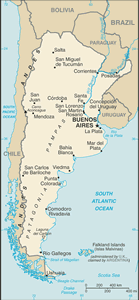The Geography of Argentina
The Geography of Argentina
Argentine Geography
Location: Southern South America, bordering the South Atlantic Ocean, between Chile and Uruguay
Geographic coordinates: 34 00 S, 64 00 W
Map references: South America
Area: total: 2,766,890 sq km land: 2,736,690 sq km water: 30,200 sq km
Area - comparative: slightly less than three-tenths the size of the US
Land boundaries: total: 9,861 km border countries: Bolivia 832 km, Brazil 1,261 km, Chile 5,308 km, Paraguay 1,880 km, Uruguay 580 km
Coastline: 4,989 km
Maritime claims: territorial sea: 12 nm contiguous zone: 24 nm exclusive economic zone: 200 nm continental shelf: 200 nm or to the edge of the continental margin
Climate: mostly temperate; arid in southeast; subantarctic in southwest
Terrain: rich plains of the Pampas in northern half, flat to rolling plateau of Patagonia in south, rugged Andes along western border
Elevation extremes: lowest point: Laguna del Carbon -105 m (located between Puerto San Julian and Comandante Luis Piedra Buena in the province of Santa Cruz) highest point: Cerro Aconcagua 6,960 m (located in the northwestern corner of the province of Mendoza)
Natural resources: fertile plains of the pampas, lead, zinc, tin, copper, iron ore, manganese, petroleum, uranium
Land use: arable land: 10.03% permanent crops: 0.36% other: 89.61% (2005)
Irrigated land: 15,500 sq km (2003)
Natural hazards: San Miguel de Tucuman and Mendoza areas in the Andes subject to earthquakes; pamperos are violent windstorms that can strike the pampas and northeast; heavy flooding
Environment - current issues: environmental problems (urban and rural) typical of an industrializing economy such as deforestation, soil degradation, desertification, air pollution, and water pollution note: Argentina is a world leader in setting voluntary greenhouse gas targets
Environment - international agreements: party to: Antarctic-Environmental Protocol, Antarctic-Marine Living Resources, Antarctic Seals, Antarctic Treaty, Biodiversity, Climate Change, Climate Change-Kyoto Protocol, Desertification, Endangered Species, Environmental Modification, Hazardous Wastes, Law of the Sea, Marine Dumping, Ozone Layer Protection, Ship Pollution, Wetlands, Whaling signed, but not ratified: Marine Life Conservation
Geography - note: second-largest country in South America (after Brazil); strategic location relative to sea lanes between the South Atlantic and the South Pacific Oceans (Strait of Magellan, Beagle Channel, Drake Passage); diverse geophysical landscapes range from tropical climates in the north to tundra in the far south; Cerro Aconcagua is the Western Hemisphere's tallest mountain, while Laguna del Carbon is the lowest point in the Western Hemisphere


